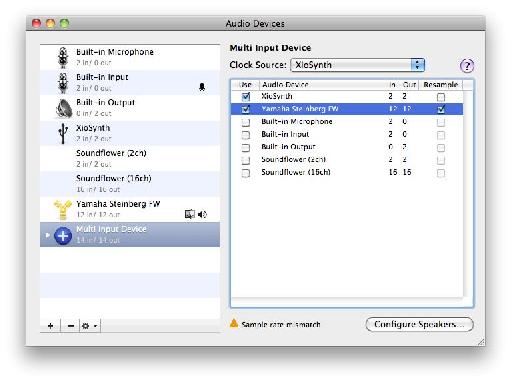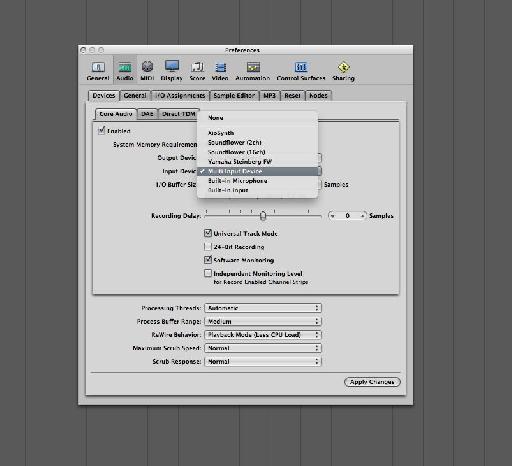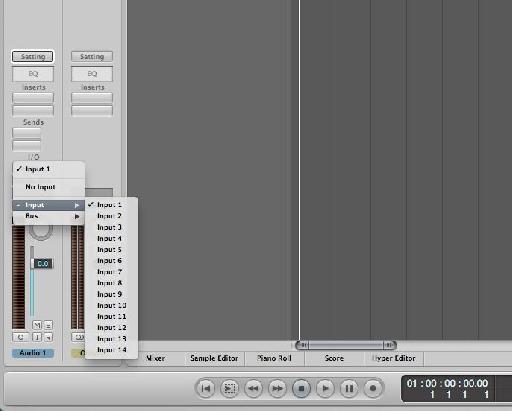10 년 이상 Mac 용과 함께 음악을 만들어왔다 누구든지 OS9의 나쁜 옛날 기억에 남는, 오디오 및 미디 컴퓨터로의 스트리밍 및 아웃시하는 것은 특별히 작성된 드라이버와 OMS MIDI 시스템에 의존하는 의미. 이들은 볼트 기능 있었고, 함께 확장 (제가 맥을 오늘에 비해 충돌하는 데 사용 빈도를 생각하면 난 아직 생각만)에 관한 OS9s 고유의 안정성 문제와 함께, 당신은 드라이버를 작성했던 사람의 자비에 더 많거나 적은 있었다 의미 장치에.
이것은 모든 CoreAudio 및 시스템 레벨에서 내장 CoreMIDI 프레임 워크를 사용하여 OS X로 변경했습니다. 개발자들은 하드웨어와 소프트웨어를 만들 때 이러한 표준을 사용할 수 있으며, 결과 데이터를 전송하기 위해 궁극적으로보다 안정적인 방법입니다. 몇 시간 전, OS X은 음악가를 위해 흔하다는 문제를 해결하지 않고 흥미로운 능력을 얻게되었습니다. 이것은 하나의 가상 장치로 집계 여러 오디오 인터페이스 또는 하드웨어 연결하는 능력입니다. 두 개의 오디오 인터페이스를 두 개의 입력과 하나가 넷과 하나가있다면, 당신은 그들 모두를 연결하는 빠른 설정을 수행하고 그들은 여섯 입력 장치로 갈가 마귀로 나타납니다하실 수 있습니다. 당신이 신체적으로 연결할 수있는대로 비늘가 너무하므로 많은 장치로 추가할 수 있습니다. DAWs 때문에 일반적으로 단지 동시에 여러 장치를보고에 여러 장치 바보를 통합, 한번에 하나의 인터페이스를 볼 수 있습니다. 그것이 어떻게 작동하는지 Heres.
1 단계
Mac의 오디오 MIDI 설정 응용 프로그램을 열고 오디오 장치 창으로 이동합니다. 새 집계 장치를 만드는 창의 왼쪽 하단에 플러스 아이콘을 클릭한 다음, 이중의 이름 필드에 클릭하고 이름을 할당합니다.
2 단계
이 예제에서 내 맥북 프로 오디오 하드웨어 및 Soundflower 가상 라우팅 장치 내장뿐만 아니라 연결된 두 개의 외부 장치가있다 볼 그것만 알면. simplicitys 제발, 내가 할 것은 두 가지 하드웨어 인터페이스로 작동하도록 지정합니다. 그래서 Xiosynth와 야마하 장치 사용 확인란을 클릭합니다.
3 단계
제 집계 장치가 지금 Xiosynth 중 2 / 2 및 야마하의 12분의 12의 합계가 14 기능과 아웃을보고있다는 그것만 알면은 사전 통보. 내 클럭 소스로 큰 야마하 장치를 설정하고 그것이 야마하와 같은 샘플 레이트에서 작동하는지 확인하기 위해 Xiosynths 탭을 있진.
4 단계
여기서 논리되고, 집계 장치에 입력과 출력을 설정하는 일이 내 갈가 마귀에서 오디오 설정을 열고 다음.
5 단계
지금은 오디오 트랙을 만들 때, 나는 트랙을 만들거나 채널 검사관으로부터 땐 나도, 그 입력 가능한 14 채널 중 하나를 사용하도록 출력을 설정할 수 있습니다. 이들은 Xiosynth에 야마하 더하기 두 명의 열두 채널에 대응.
6 단계
다음 이유에서 설정한 같은이며 사용 가능한 14 기능과 아웃있다는 것을 다시 확인할 것이다. 당신이 더 필요하면 더 많은 장치를 추가하거나 심지어 사용하는 내장된 Mac의 오디오 하드웨어, 그건 dedicted 단위와 같은 녹음 품질을 제공합니다 실거예요 불구하고. 할 수있다









 © 2024 Ask.Audio
A NonLinear Educating Company
© 2024 Ask.Audio
A NonLinear Educating Company
Discussion
I'd love to see Audio MIDI Setup allow for custom I/O names which could be read by all DAWs using Core Audio...
btw, in Logic 8 and 9 you can assign labels to input, output and bus channels. In the Mixer's local menu choose: Options > I/O Labels...
The labels you create here are global, so will be be visible for all projects (past, present and future)
:)
BTW, awesome stuff Hollin! I've been enjoying your articles since you joined up with MPV :-)
Cheers!
Do you know which device should be set as the clock master? I chose Traveler#1. The documentation says to chose the hardware device that is the master. However, the only options are Travelers#1 and #2 (not Rosetta). It seems to work, but I want to make sure I'm not missing anything. Thanks!
Want to join the discussion?
Create an account or login to get started!